Earth is planet surrounded by so many ocean. For almost two or third of Earth are covered by oceans. However, many things that we do not know about oceans. Some said that we are more aware to every solar systems than our oceans. On the other hand, among what oceans have, there are several species of animals live on it. The types of animals are rarely can be seen. Thus animals mostly live in deep of ocean approximately up to 200 meters in depth. Even though, in fact, there are possibly no living existence, several animals of ocean still live there. Some of them are recorded as endangered animlas in the world. Here several animals in ocean.
Hawksbill Sea Turtle (Eretmochelys imbricate)
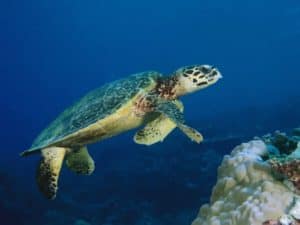 Hawksbill Turtle is a kind of reptile with the scientific name of Eretmochelys imbricata. It includes family Chelonidae. It can grow up to 24 to 45 in or 62.5 to 114 cm with the weight of 100 to 150 lbs or 45 to 68 kg. It eats marine algae, mollusks, sea urchins, crustaceans, fish and jellyfish. Then, it lives near reefs rich in the sponges for its feeding place in tropical region of Pacific, Atlantic and Indian ocean.The predators are large fish, crocodiles, octopuses, sharks, and human. The status is an endangered species. Every two to three years it mates located in shallow waters near the shore.
Hawksbill Turtle is a kind of reptile with the scientific name of Eretmochelys imbricata. It includes family Chelonidae. It can grow up to 24 to 45 in or 62.5 to 114 cm with the weight of 100 to 150 lbs or 45 to 68 kg. It eats marine algae, mollusks, sea urchins, crustaceans, fish and jellyfish. Then, it lives near reefs rich in the sponges for its feeding place in tropical region of Pacific, Atlantic and Indian ocean.The predators are large fish, crocodiles, octopuses, sharks, and human. The status is an endangered species. Every two to three years it mates located in shallow waters near the shore.
Hawksbill does migration from feeding sites to nesting grounds on tropical beaches. The nests are found even between the Carolinas and New Jersey.
- Steller Sea Lion (Eumetopias jubatus)
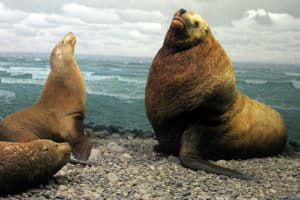 Steller Sea Lion is a kind of mammalia with the scientific name of Eumetopias jubatas. It includes family Otariidae. It has the length of 10-11 feet or 3-3.4 meters with the weight of 1,120 kg for males and 7.5-9.5 feet or 2.5-3.0 meters with the weight of 350 kg for females. It is listed as endangered pieces. It mates for 10-14 days after its pups are born.
Steller Sea Lion is a kind of mammalia with the scientific name of Eumetopias jubatas. It includes family Otariidae. It has the length of 10-11 feet or 3-3.4 meters with the weight of 1,120 kg for males and 7.5-9.5 feet or 2.5-3.0 meters with the weight of 350 kg for females. It is listed as endangered pieces. It mates for 10-14 days after its pups are born.
This animal eats fishes, invertebrates and pinnipeds. It prefers the colder temperature to sub-arctic waters in North Pacific Ocean.
The predators are killer whales (orcas), white sharks and human. Mature males mate with many females. In the breading season, males do not eat.
- Hammerhead Shark (Sphyrna mokarran)
 Hammerhead Shark is a kind of shark with the scientific name of Sphyrna mokarran. It includes the family Sphyyrnidae with two genera: Eusphyra (one species) and Sphyrna (nine species). The largest, namely Hammerhead Shark (Sphyrna mokarran), has total length of 25 feet with the weight of 1,000 pounds. On the other hand, It inhabitates temperate and tropical water along coastal line and continental shelf. It is enlisted as an endangered species.
Hammerhead Shark is a kind of shark with the scientific name of Sphyrna mokarran. It includes the family Sphyyrnidae with two genera: Eusphyra (one species) and Sphyrna (nine species). The largest, namely Hammerhead Shark (Sphyrna mokarran), has total length of 25 feet with the weight of 1,000 pounds. On the other hand, It inhabitates temperate and tropical water along coastal line and continental shelf. It is enlisted as an endangered species.
Then, It eats stringrays, batoid, groupers, sea catfishes, small bony fishes, crabs, squid, other sharks, rays and lobsterns. The life span of Hammerhead Sharks reaches 20-30 years of age. There is almost no predator except human. Young hammerhead sharks are born in summer.
- Vaquita (Phoeocna sinus)
 Vaquita is a kind of mammalia. It has the Phylum Chordata, the family Phocoenidae and the scientific name of Phocoena sinus. It has the length of 4.6 feet or 1.4 meters (male) and 5 feet or 1,52 meters (female). Vaquita eats croakers, grunts, squid, crustaceans and octopus. The weight reaches 120 lbs or 54,4 kg.
Vaquita is a kind of mammalia. It has the Phylum Chordata, the family Phocoenidae and the scientific name of Phocoena sinus. It has the length of 4.6 feet or 1.4 meters (male) and 5 feet or 1,52 meters (female). Vaquita eats croakers, grunts, squid, crustaceans and octopus. The weight reaches 120 lbs or 54,4 kg.
It inhabites the northern Gulf of California, Mexico including Colorado River Delta Biosphere Reserve.
The habitat is in warm, shallow waters with the depth of less than 40 meters. The mating season occurs from April to May. The life span reaches 20 years. Predators are large sharks, killer whales, Orcinus orca and human activities from fishing, sea pollution to climate change.
- Blue Whale (Balaenoptera musculus)
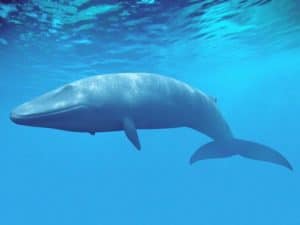 Blue Whale is a kind of marine mammal. It includes Phylum Chordata and Family Balaenopteridae with the scientific name of Balaenoptera musculus. It has the length of 98 feet or 30 meters with the weight of 173-181 tons. The habitat is almost all oceans except Arctic. It does not inhabite Mediterranean, Okhotsk and Bering seas. The blue whale’s mating system is not known yet. It bears one calf per 2-3 years.
Blue Whale is a kind of marine mammal. It includes Phylum Chordata and Family Balaenopteridae with the scientific name of Balaenoptera musculus. It has the length of 98 feet or 30 meters with the weight of 173-181 tons. The habitat is almost all oceans except Arctic. It does not inhabite Mediterranean, Okhotsk and Bering seas. The blue whale’s mating system is not known yet. It bears one calf per 2-3 years.
It eats krill totaling 40 million krill each day in summer. It has shorter inter-breeding interval. Predators are very few consisting of killer whales or orcas and human activities from ship strikes to climate change.
- Florida Manatee (Trichechus manatus latirostris)
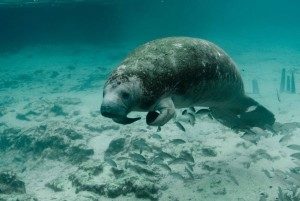 Florida Manatee is a kind of mammalia. It includes Phylum Chordata and Family Trichechidae. West Indian manatee (Trichechus manatus) or “sea cow” consists of Florida manatee (Trichechus manatus latirostris) and Antillean or Caribbean manatee (Trichechus manatus manatus). The two species are endangered species. It eats sea grasses, fish and small invertebrates. Crystal River and Blue Springs region in Florida and along Atlantic Coast and Forida Gulf Coast are its habitat. The life span reaches 28 years old.
Florida Manatee is a kind of mammalia. It includes Phylum Chordata and Family Trichechidae. West Indian manatee (Trichechus manatus) or “sea cow” consists of Florida manatee (Trichechus manatus latirostris) and Antillean or Caribbean manatee (Trichechus manatus manatus). The two species are endangered species. It eats sea grasses, fish and small invertebrates. Crystal River and Blue Springs region in Florida and along Atlantic Coast and Forida Gulf Coast are its habitat. The life span reaches 28 years old.
Predators are human activities, namely collisions with boat propeller blades. The natural threat relates to warm-water habitat for climate change.
- Hawaiian Monk Seal (Neomonachus schauinslandi)
 Hawaiian Monk Seal is a kind of mammalia. It includes Phylum Chordata and Family Phocidae with the scientific name of neomonachus schauinslandi which the former name of monachus schauinslandi. Hawaiian Monk Seal has two other species, i.e. Mediterranean Monk Seal and Caribbean Monk Seal. They are extinct. It has the length of 7.0-7.5 feet or 2.1-2.3 meters with the weight of 375-450 pounds or 170-250 kg. Fish, cephalopods and crustacean become its diet. It inhabites warm subtropical waters, surrounding atolls, islands, offshore on reefs and submerged banks.
Hawaiian Monk Seal is a kind of mammalia. It includes Phylum Chordata and Family Phocidae with the scientific name of neomonachus schauinslandi which the former name of monachus schauinslandi. Hawaiian Monk Seal has two other species, i.e. Mediterranean Monk Seal and Caribbean Monk Seal. They are extinct. It has the length of 7.0-7.5 feet or 2.1-2.3 meters with the weight of 375-450 pounds or 170-250 kg. Fish, cephalopods and crustacean become its diet. It inhabites warm subtropical waters, surrounding atolls, islands, offshore on reefs and submerged banks.
It lives in US waters particularly in the Northwestern Hawaiian Islands despite it is also seen in Necker and Island and Nihoa Island. It is an endangered species for climate change, impact of fisheries and natural threat such as limited food source, low genetic diversity.
- Kemp’s Ridley Turtle (Lepidochelys kempii)
 Kemp’s Ridley Turtle is a kind of turtle. It includes Phylum Chordata and Family Cheloniidae with the scientific name of lepidochelys kempii. It is also known as Atlantic ridley sea turtle. It has the length of 24-28 inches or 60-70 cm with the weight of 36-45 kg. So, it is a small sea turtle. Crabs, fish, jellyfish and mollusks are its diet. It inhabites neritic zones containing muddy or sandy bottoms. In the location, prey can be found. It is found in Gulf of Mexico. Female turtle migrates to and from nexting beaches in Mexico. So, it is distributed in Gulf of Mexico and U.S. Atlantic seaboard from Florida to New England.
Kemp’s Ridley Turtle is a kind of turtle. It includes Phylum Chordata and Family Cheloniidae with the scientific name of lepidochelys kempii. It is also known as Atlantic ridley sea turtle. It has the length of 24-28 inches or 60-70 cm with the weight of 36-45 kg. So, it is a small sea turtle. Crabs, fish, jellyfish and mollusks are its diet. It inhabites neritic zones containing muddy or sandy bottoms. In the location, prey can be found. It is found in Gulf of Mexico. Female turtle migrates to and from nexting beaches in Mexico. So, it is distributed in Gulf of Mexico and U.S. Atlantic seaboard from Florida to New England.
On the other hand, the life span is not known. The predator is in nesting beaches and marine environment particularly human activities from fishing to illegal egg collection.
- Humpback Whale (Megaptera novaeangliae)
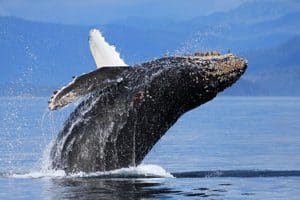 Humpback Whale is a kind of mammalia. It includes Phylum Chordata and Family Balaenopteridae with the scientific name of Megaptera novaeangliae. It has the length of 60 feet or 18 meters with total weight of 25-40 tons or 22.000 – 36.000 kg. Its female is larger than male. Its diet includes krill, crustaceans, plankton and small fish. It consumes 1360 kg krill per day. It lives in all ocean surfaces from equator to sub-polar latitude. In mating activities, a whale male competes with another for getting its female in wintering grounds. The meting occurs once per two years or twice in a three year span.
Humpback Whale is a kind of mammalia. It includes Phylum Chordata and Family Balaenopteridae with the scientific name of Megaptera novaeangliae. It has the length of 60 feet or 18 meters with total weight of 25-40 tons or 22.000 – 36.000 kg. Its female is larger than male. Its diet includes krill, crustaceans, plankton and small fish. It consumes 1360 kg krill per day. It lives in all ocean surfaces from equator to sub-polar latitude. In mating activities, a whale male competes with another for getting its female in wintering grounds. The meting occurs once per two years or twice in a three year span.
Futhermore, the threats come from human activities from fishing, ship strikes, habitat impact for climate change and harvest.
- Fraser’s Dolphin (Lagenodelphis hosei)
 Fraser’s Dolphin is a kind of mammalia. It includes Phylum Chordata and Family Delphinidae with the scientific name of Lagenodelphis hosei or Sarawak dolphin. In a group of hundreds to thousands dolphins, they swim. It has the length of 6-9 feet or 2-2.7 meters with the weight of 160-210 kg. The life span reaches 18 years or more. Mesopelagic fish, shrimp, squid and octopus are its favorite diet. It indicates Fisher’s dolphins can swim to deep sea where its preys are located. The habitat is in warm temperate, subtropical and tropical pelagic water with the depth of more than 3,300 feet or 1000 meters.
Fraser’s Dolphin is a kind of mammalia. It includes Phylum Chordata and Family Delphinidae with the scientific name of Lagenodelphis hosei or Sarawak dolphin. In a group of hundreds to thousands dolphins, they swim. It has the length of 6-9 feet or 2-2.7 meters with the weight of 160-210 kg. The life span reaches 18 years or more. Mesopelagic fish, shrimp, squid and octopus are its favorite diet. It indicates Fisher’s dolphins can swim to deep sea where its preys are located. The habitat is in warm temperate, subtropical and tropical pelagic water with the depth of more than 3,300 feet or 1000 meters.
Thus, it lives in all oceans. Its breeding occurs between 5-10 years of age. Its female bears between spring and autumn per two years. The threats are due to human activities from fishing and the killed target in some countries.
- Elephant Seals (Mirounga)
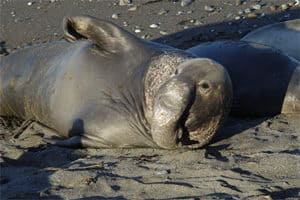 Sea Elephant or Elephant Seals is a kind of Mammalia. It includes Phylum Chordata and Family Phocidae with the scientific name of Mirounga. There are two species, i.e. Northern elephant seal (Mirounga leonina) and Southern elephant seal (Mirounga leonina). The diet are carnivores. The breeding occurs one a year. The life span is for 9 years for northern elephant seals and 22-22 years for southern elephant seals. It has the length of more than 20 feet with the weight of 4-5 tons. Northern elephant seal is found in North Pacific and Southern elephant seal in Antarctic Ocean.
Sea Elephant or Elephant Seals is a kind of Mammalia. It includes Phylum Chordata and Family Phocidae with the scientific name of Mirounga. There are two species, i.e. Northern elephant seal (Mirounga leonina) and Southern elephant seal (Mirounga leonina). The diet are carnivores. The breeding occurs one a year. The life span is for 9 years for northern elephant seals and 22-22 years for southern elephant seals. It has the length of more than 20 feet with the weight of 4-5 tons. Northern elephant seal is found in North Pacific and Southern elephant seal in Antarctic Ocean.
- White Abalone (Haliotis sorenseni)
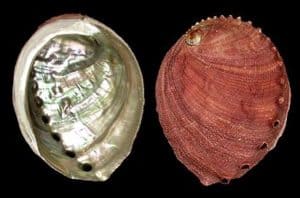 White Abalone is a kind of large sea snail. The Phylum is Mollusca and Family Haliotidae with the scientific name of Haliotis sorenseni. The length reaches 5-8 inches or 13-20 cm and the weight is 1.7 pounds or 0.8 kg. The life span reaches 34-40 years. Its diet is algae. The breading occurs when female and male release eggs and sperm into the surrounding water to be fertilized. The habitat is in open low and high relief rock. It is also found in boulder habitat with sand channels as the concentration of drift macroalgae and red algae in the depth of 80-100 feet or 25-30 m.
White Abalone is a kind of large sea snail. The Phylum is Mollusca and Family Haliotidae with the scientific name of Haliotis sorenseni. The length reaches 5-8 inches or 13-20 cm and the weight is 1.7 pounds or 0.8 kg. The life span reaches 34-40 years. Its diet is algae. The breading occurs when female and male release eggs and sperm into the surrounding water to be fertilized. The habitat is in open low and high relief rock. It is also found in boulder habitat with sand channels as the concentration of drift macroalgae and red algae in the depth of 80-100 feet or 25-30 m.
The favorite habitat is in Santa Barbara county, California and some offshore islands and banks. Filter-feeding animals eats eggs and larvae. Crabs, lobsters, octopuses, starfish, fish and predatory snails prey juvenile abalone. Cabezon is the predator of large abalone.
- Right Whales (Eubalaena)
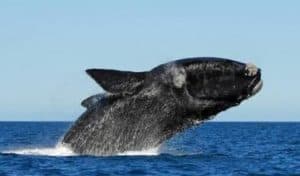 Right Whales are Mammalia. The Phylum is Chordata and Family Balaendae with the scientific name of Eubalaena. There are four species of Right Whales with different habitats, i.e. Atlantic Northern Right Whales (Eubalaena glacialis), Pacific Northern Right Whales (Eubalaena japonica), Southern Right Whales (Eubalaena australis) and Bowhead Whales (Balaena mysticetus). The diet is zooplankton, tiny crustaceans, krill and pteropods. It has the length of 50 feet or and the weight is 70 tons.
Right Whales are Mammalia. The Phylum is Chordata and Family Balaendae with the scientific name of Eubalaena. There are four species of Right Whales with different habitats, i.e. Atlantic Northern Right Whales (Eubalaena glacialis), Pacific Northern Right Whales (Eubalaena japonica), Southern Right Whales (Eubalaena australis) and Bowhead Whales (Balaena mysticetus). The diet is zooplankton, tiny crustaceans, krill and pteropods. It has the length of 50 feet or and the weight is 70 tons.
The breeding occurs per 3-5 years. Winter months are favorite for Right Whales’ reproduction and calving. The life span reaches 70 years. The predators are killer whale and humans.
- Short-tailed Albatross (Phoebastria albatrus)
 Short-tailed Albatross is a kind of bird. The phylum is Chordata and Family Diomedeidae with the scientific name of Phoebastria albatrus. The wingpan reaches 13 feet and the weight of 25 pounds. It is the largest albatros in the North Pacific. It eats flying fish eggs, crustaceans, shrimp, and squid. The nest is on islands off Japan, particularly Torishima and Minami-Kojima. It occurs from August to December. Most of their life is in opean ocean water and islands. The life span reaches 40-60 years old.
Short-tailed Albatross is a kind of bird. The phylum is Chordata and Family Diomedeidae with the scientific name of Phoebastria albatrus. The wingpan reaches 13 feet and the weight of 25 pounds. It is the largest albatros in the North Pacific. It eats flying fish eggs, crustaceans, shrimp, and squid. The nest is on islands off Japan, particularly Torishima and Minami-Kojima. It occurs from August to December. Most of their life is in opean ocean water and islands. The life span reaches 40-60 years old.
It is found in North of the Tropic of Cances, Pacific Ocean. The nest in Torishima is vulnerable to other natural disasters, and it is the threat to the bird. The other threats are pollution and fisheries. The predators are Tiger Sharks and Whales.
- Green Turtle (Chelonia mydas)
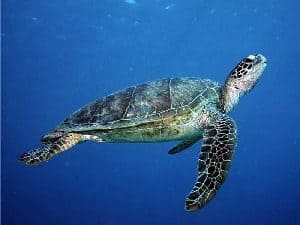 Green turtle is a kind of reptile. It includes Phylum Chordata and Family Cheloniidae with the scientific name of Chelonia mydas. It is also known as green turtle, black (sea) turtle or Pacific green turtle. Its life span reaches more than 80 years of age. It has the length of 5 feet or 1,5 meters with the weight of 317,5 kg. The life span is over 80 years. The habitat is in Pacific Ocean, Atlantic Ocean and Indian Ocean particularly from warm tropical to subtropical water. The diet is sea grass. It can do migration from its feeding ground to its nesting sites totaling 2,600 km.
Green turtle is a kind of reptile. It includes Phylum Chordata and Family Cheloniidae with the scientific name of Chelonia mydas. It is also known as green turtle, black (sea) turtle or Pacific green turtle. Its life span reaches more than 80 years of age. It has the length of 5 feet or 1,5 meters with the weight of 317,5 kg. The life span is over 80 years. The habitat is in Pacific Ocean, Atlantic Ocean and Indian Ocean particularly from warm tropical to subtropical water. The diet is sea grass. It can do migration from its feeding ground to its nesting sites totaling 2,600 km.
The breeding occurs from July to December. The threats are primarily from human due to injury from boat propellers, pollution and fishery. Predators are birds, crabs and raccoons for newly hatched sea turtles. It is an endangered species.
- African Penguin (Spheniscus demersus)
 African Penguin is a kind of penguin. The phylum is Chordata and Family Spheniscidae with the scientific name of Spheniscus demersus. It eats fish, squid and small crustaceans. The tall of African penguins reaches 27 inches or 60 cm with the weight is 7-11 pounds or 2.5 – 4 kg. It lives and breeds on the coast of South Africa and on the off shore islands. Guano covering the grounds makes nesting areas destroyed. The numbers decreases and it is an endangered species. The breeding occurs from March to May in South Africa and November and December in Namibia.
African Penguin is a kind of penguin. The phylum is Chordata and Family Spheniscidae with the scientific name of Spheniscus demersus. It eats fish, squid and small crustaceans. The tall of African penguins reaches 27 inches or 60 cm with the weight is 7-11 pounds or 2.5 – 4 kg. It lives and breeds on the coast of South Africa and on the off shore islands. Guano covering the grounds makes nesting areas destroyed. The numbers decreases and it is an endangered species. The breeding occurs from March to May in South Africa and November and December in Namibia.
The female fertile reaches 10 years. The life span reaches 10-27 years in the wild and 30 in captivity. The predators comprise sharks, Cape fur seals, orcas in the sea and mongooses, genets, caracals, leopards, domestic cats and kelp gull on the land.
- Gray Whale (Eschrichtius robustus)
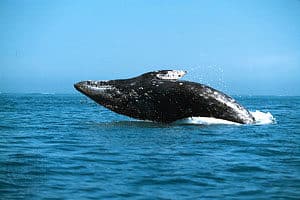 Gray Whale is a kind of mammalia with Phylum Chordata and Family Eschrichtiidae with the scientific name of Eschrichtius robustus. It has the length of 45 feet or 14 meters and its female is larger than the males. The weight is 30-40 tons. It is only found in Pacific Ocean. It eats benthic crustaceans, amphipods and isopods. It frequently does migration from Arctic Ocean in summer, Baja California, Mexico for birth and mating, California in Desember and January during its southern migration to the same place in March, April and May in its northern journey.
Gray Whale is a kind of mammalia with Phylum Chordata and Family Eschrichtiidae with the scientific name of Eschrichtius robustus. It has the length of 45 feet or 14 meters and its female is larger than the males. The weight is 30-40 tons. It is only found in Pacific Ocean. It eats benthic crustaceans, amphipods and isopods. It frequently does migration from Arctic Ocean in summer, Baja California, Mexico for birth and mating, California in Desember and January during its southern migration to the same place in March, April and May in its northern journey.
The threats are particularly human activities, climate change and polution. Its nest areas in Mexico Gulf is in danger for pollution and fossil oil exploration. It makes the species in danger
- Sea Otters(Enhydra lutris)
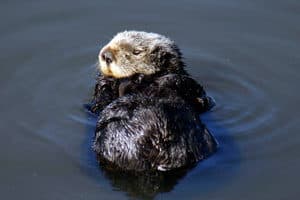 Sea Otters is a kind of mammalia. The phylum is Chordata and Family Mustelidae with the scientific name of Enhydra lutris. It is known as the second smallest marine mammals in the world. It eats abalone, urchins, mussels, clams, crabs, snails and other marine species. It has the length of 4 feet and and the weight is 45 lbs (females) and 65 lbs (males). The lifespan reaches 10-15 years (males) and 15-20 years (female). The habitat is shallow coastal waterss off the northern Pacific from Japang to Alaska and Baja California. Mostly it is found in Alaskan waters.
Sea Otters is a kind of mammalia. The phylum is Chordata and Family Mustelidae with the scientific name of Enhydra lutris. It is known as the second smallest marine mammals in the world. It eats abalone, urchins, mussels, clams, crabs, snails and other marine species. It has the length of 4 feet and and the weight is 45 lbs (females) and 65 lbs (males). The lifespan reaches 10-15 years (males) and 15-20 years (female). The habitat is shallow coastal waterss off the northern Pacific from Japang to Alaska and Baja California. Mostly it is found in Alaskan waters.
Then, tt has two sea otter subspecies, namely the Northern sea otter (Enhydra lutris kenyoni) and the Southern sea otter (Enhydra lutris nereis). It can dive up to 330 feet for reaching its food. The breeding season occurs throughout the year. The predators are orcas, shark, sea lion and bald eagle in sea and on the land they are bears and coyotes. Human activities make the species in danger, such as pollution, fur trader, habitat degradation.
- Atlantic Bluefin Tuna (Thunnus thynnus)
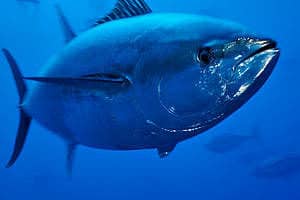 Atlantic Bluefin Tuna is a kind of tuna. It includes Phylum Chordata and Family Scombridae with the scientific name of Thunnus thynnus. It has the size of 6.5 feet or 2 meters and the weight of 550 lbs or 250 kg. Average life span reaches 15 years old. There are several species of tuna with Genus Thunnus, such as Southern bluefin tuna (Thunnus maccoyii), Pacific bluefin tuna (Thunnus orientalis). The habitat is in the western Atlantic from Gulf of Mexico and the Caribbean Sea to Brazil despite it disappears in offshore of Brazil.
Atlantic Bluefin Tuna is a kind of tuna. It includes Phylum Chordata and Family Scombridae with the scientific name of Thunnus thynnus. It has the size of 6.5 feet or 2 meters and the weight of 550 lbs or 250 kg. Average life span reaches 15 years old. There are several species of tuna with Genus Thunnus, such as Southern bluefin tuna (Thunnus maccoyii), Pacific bluefin tuna (Thunnus orientalis). The habitat is in the western Atlantic from Gulf of Mexico and the Caribbean Sea to Brazil despite it disappears in offshore of Brazil.
In the eastern Atlantic, it can be seen from Norway to the Canary Islands or from Mauritania to offshore of South Africa as well as in the Mediterranean Sea and the southern Black Sea. In the mating season, tuna will return to the place where it was born. The predators are killer whales, sharks and other big fish. The threat is related to human activities, i.e. overfishing. It makes the population drop. It occurs to all tunas.
- Dugong (Dugon dugon)
 Dugong is a kind of Mammals with the scientific name of Dugon dugon. It includes Phylum Chordata and Family Dugongidae. It has the length of 8-10 feet or 2,4 – 3 meters with the weight of 500 – 1,100 lbs or 227 – 454 kg. The life span reaches 70 years old. The habitat is in mangrove channels, bay, waters of large inshore island and inter-reefal water throughout Western and Central Water of Pacific Ocean including Africa’s sea coast. There are two waters with high concentration of Dugong, namely the Arabian Gulf and the Northern Waters of Australia between Shark Bay and Moreton Bay.
Dugong is a kind of Mammals with the scientific name of Dugon dugon. It includes Phylum Chordata and Family Dugongidae. It has the length of 8-10 feet or 2,4 – 3 meters with the weight of 500 – 1,100 lbs or 227 – 454 kg. The life span reaches 70 years old. The habitat is in mangrove channels, bay, waters of large inshore island and inter-reefal water throughout Western and Central Water of Pacific Ocean including Africa’s sea coast. There are two waters with high concentration of Dugong, namely the Arabian Gulf and the Northern Waters of Australia between Shark Bay and Moreton Bay.
Female dugong’s sexual maturity is around 6 years and it bears calf from 6 years to 17 years. The female will suckle its calfs for 18 months. The life span reaches 70 years or more in the wild. Dugong is usually found in a group of 2-200 individuals. The predators are crocodile, killer whale and shark. It mostly eats sea-grass meadows.
- Leatherback Turtle (Dermochelys coriacea)
 Leatherback sea turtle is a kind of Reptilia with the scientific name of Dermochelys coriacea. It includes Phylum Chordata and Family Demochelyidae. It has the length of 180 cm and 500 kg in weight. Leatherback sea turtle lives in open water and coastal habitat. Adult Leatherback sea turtle lives in open ocean with temperature of under 10 degrees Celsius. The juvenile likes in tropical water with temperature of over 26 degrees Celsius particularly coastal water. Female comes to the nesting area once per two or three years.
Leatherback sea turtle is a kind of Reptilia with the scientific name of Dermochelys coriacea. It includes Phylum Chordata and Family Demochelyidae. It has the length of 180 cm and 500 kg in weight. Leatherback sea turtle lives in open water and coastal habitat. Adult Leatherback sea turtle lives in open ocean with temperature of under 10 degrees Celsius. The juvenile likes in tropical water with temperature of over 26 degrees Celsius particularly coastal water. Female comes to the nesting area once per two or three years.
Moreover, the diet of this turtle includes squid, tunicate and jellyfish. The threat comes from illegal trading, climate change, pollution, habitat degradation.
- Sawfish (Pristis pectinata)
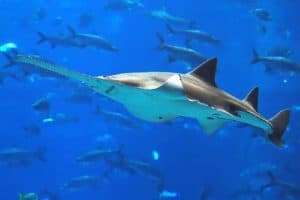 Sawfish is a kind of rays with the scientific name of Pristis pectinata. It is also known as Smalltooth sawfish. It is a rays but the body is like shark. It includes Phylum Chordata and Family Pristidae. The length reaches 18 feet or 5,5 meters. It is found particularly in shallow coastal waters with the depth of 400 feet or 123 meters. The juvenile likes shallow coastal waters in Atlantic Ocean. The teeth amount to 22-29. The diet includes small fishes, prawns, and other crustaceans. Sawfish is enlisted as an endangered species.
Sawfish is a kind of rays with the scientific name of Pristis pectinata. It is also known as Smalltooth sawfish. It is a rays but the body is like shark. It includes Phylum Chordata and Family Pristidae. The length reaches 18 feet or 5,5 meters. It is found particularly in shallow coastal waters with the depth of 400 feet or 123 meters. The juvenile likes shallow coastal waters in Atlantic Ocean. The teeth amount to 22-29. The diet includes small fishes, prawns, and other crustaceans. Sawfish is enlisted as an endangered species.
Futhermore, the threat comes from human activities particularly fisheries. The predators are sharks and shalwater crocodiles.
- Humphead Wrasse (Cheilinus undulatus)
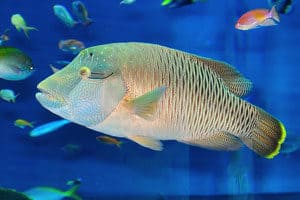 Humphead wrasse is a kind of reef fish with the scientific name of Cheilinus undulatus. It includes Phylum Chordata and Family Labridae. It prefers outer reefs located mostly in Southeastern Asia. It is found from Western Pacific Ocean from Red Sea to South Africa and Tuamoto Islands (Polynesia). It is seen in Ryukyu Islands to New Caledonia as well.
Humphead wrasse is a kind of reef fish with the scientific name of Cheilinus undulatus. It includes Phylum Chordata and Family Labridae. It prefers outer reefs located mostly in Southeastern Asia. It is found from Western Pacific Ocean from Red Sea to South Africa and Tuamoto Islands (Polynesia). It is seen in Ryukyu Islands to New Caledonia as well.
Humphead wrasse can live up to 30 years. It reaches the sexual maturity around six years. It is the hermaphroditic species,its changing from female to male.
These fishes eats molluscan, fish, sea urchins, crustaceans, echinoderms and other invertebrates. The natural predators are sea hares, box-fishes and crown-of-thorns starfish.Threat comes from human activities, ie. fisheries.
- Polar Bear (Ursus maritimus)
 Polar Bear is a kind of bear with the scientific name of Ursus maritimus. It includes Phylum Chordata and Family Ursidae. Polar bear can be included in ocean animal because it gives birth and hunts on sea ice in Arctic Ocean for many months of the year. The diet includes seals, fish, seabirds and reindeer, berries and other plants. It can swim up to 60 miles and dive to the depth of 15 feet and stay under water for about two minutes. The mating of Polar bears occurs in late winter and early spring or from March to June. A winter den on land is dug into the snow near the coast with the range of 8 km during October or November.
Polar Bear is a kind of bear with the scientific name of Ursus maritimus. It includes Phylum Chordata and Family Ursidae. Polar bear can be included in ocean animal because it gives birth and hunts on sea ice in Arctic Ocean for many months of the year. The diet includes seals, fish, seabirds and reindeer, berries and other plants. It can swim up to 60 miles and dive to the depth of 15 feet and stay under water for about two minutes. The mating of Polar bears occurs in late winter and early spring or from March to June. A winter den on land is dug into the snow near the coast with the range of 8 km during October or November.
Female bears two cubs under its mother’s den from November to January. The predators are other polar bears and human. For climate change, it melts sea ice. Polar bear has to adopt the land-based summer lifestyle. It will be dangerous because it has to compete with brizzly or brown bears and human. It will influence reproductive cycle as well.
- Whale Shark (Rhincodon typus)
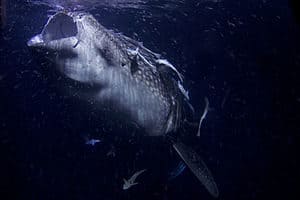 Whale Shark is a kind of fish with the scientific name of Rhincodon typus. It includes Phylum Chordata and Family Rhincodontidae. It is considered as the world’s largest living fish. The habitat is tropical and warm temperate waters in Atlantic Ocean and Indo-Pacific Ocean. It has the weight of 19,000 kg and the length of 11-12 m. The lifespan reaches 70 years. It feeds by filtering food in a kind of small fish, copepods, krill, fish egg, Christmas Island red crab larvae and small squid.
Whale Shark is a kind of fish with the scientific name of Rhincodon typus. It includes Phylum Chordata and Family Rhincodontidae. It is considered as the world’s largest living fish. The habitat is tropical and warm temperate waters in Atlantic Ocean and Indo-Pacific Ocean. It has the weight of 19,000 kg and the length of 11-12 m. The lifespan reaches 70 years. It feeds by filtering food in a kind of small fish, copepods, krill, fish egg, Christmas Island red crab larvae and small squid.
Whale shark reproduces eggs by keeping inside the mother. It keeps up until the pups are fully developed. The food of the pups is from surrounding Whale shark’s mother. So, it is called ovoviviparus. Blue marlin, Makaira nigracans, blue shark and killer whale are predators of juvenile whale shark. The threat are human activities from fisheries to vessel strikes.
- Olive Ridley Sea Turtle (Lepidochelys olivacea)
 Olive Ridley Sea Turtle is a kind of Reptile with the scientific name of Lepidochelys olivacea. It includes Phylum Chordata and Family Chelonidae. It has the size of 2 – 2.5 feet or 62 – 60 cm and the weight of 100 lbs or 45 kg.
Olive Ridley Sea Turtle is a kind of Reptile with the scientific name of Lepidochelys olivacea. It includes Phylum Chordata and Family Chelonidae. It has the size of 2 – 2.5 feet or 62 – 60 cm and the weight of 100 lbs or 45 kg.
It is known as the smallest of the sea turtles in the world. It lives in open ocean. Despite it lives in open ocean, the favorite habitat is in coastal areas, bays and estuaries. It eats algae, lobster, crabs, tunicates, mollusks, small fish.
The nesting sites are on tropical and subtropical beaches throughout the world. The tropical regions are in South Atlantic Ocean, Pacific Ocean and Indian Ocean. The population is considered abundant, and it is not enlisted in an endangered species. The threat comes from human from collection of turtle eggs, killing turtles and accidental fishing activites.
- Galapagos Giant Tortoise (Chelonoidis nigra)
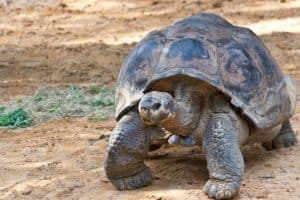 Galapagos Giant Tortoise is a kind reptilia. The phylum is Chordata and Family Testudinidae with the scientific name of Chelonoidis nigra). It grows up to 40-50 years. It has 5 feet tall and the weight of 500 pounds. The life span more than 100 years and the oldest 152 years old.
Galapagos Giant Tortoise is a kind reptilia. The phylum is Chordata and Family Testudinidae with the scientific name of Chelonoidis nigra). It grows up to 40-50 years. It has 5 feet tall and the weight of 500 pounds. The life span more than 100 years and the oldest 152 years old.
The habitat is in Galapagos Isles. The Giant Tortoises is just one species, Geochelone elephantopus. It has different races or sub-species and of them four are extinct. Lonesome George, one of the extinct, exists at Charles Darwin Research Station.
Meanwhile, the diet is only vegetable including cactus, fruits, vines, grasses and other vegetation. The breeding occurs from January to August. The predators are black rats and feral cats. Pig, dog, rat and cat ruin natural vegetation and it interrupt the reproduction of Galapagos Giant Tortoise
- Killer Whale (Orcinus orca)
 Killer Whale is a kind of Mammalia. The phylum is Chordata and Family Delphinidae with the scientific name of Orcinus orca. It has the length of 32 feet or 10 meters (male) and 28 feet or 8.5 meters (female) with the weight of 10,000 kg (male) and 7,500 kg (female). The lifespan reaches 50-100 years. The diet includes fish, sharks, marine mammals and sea birds. However, it depends on geographic or population condition. The habitat is found in all parts of the oceans particularly in colder water including Antartctica, North Atlantic and Pacific Ocean.
Killer Whale is a kind of Mammalia. The phylum is Chordata and Family Delphinidae with the scientific name of Orcinus orca. It has the length of 32 feet or 10 meters (male) and 28 feet or 8.5 meters (female) with the weight of 10,000 kg (male) and 7,500 kg (female). The lifespan reaches 50-100 years. The diet includes fish, sharks, marine mammals and sea birds. However, it depends on geographic or population condition. The habitat is found in all parts of the oceans particularly in colder water including Antartctica, North Atlantic and Pacific Ocean.
M0reover, it is also found in tropical, subtropical and offshore waters. The threats are illegel hunting of Killer Whales and human activities, such as pollution, ship coallisions. There is no predator because Killer Whale is at the top of the food chain except human.
- Ocean sunfish (Mola mola)
 Ocean sunfish is a kind of fish. The phylum is Chordata and Family Molidae with the scientific name of Mola mola. It has the length of 11 feet or 3.3 meters with the weight of 2,250 kg. The life span is not known in the wild and ten years in captivity. The habitat is found in temperate and tropical oceans around the world. The diet is salps, squid, crustaceans, fish larvae and eel grass. Human activities are the threat of Ocean Sunfish, such as being snagged in drift gill and eating plastic bags resembling jellyfish, commercial product.
Ocean sunfish is a kind of fish. The phylum is Chordata and Family Molidae with the scientific name of Mola mola. It has the length of 11 feet or 3.3 meters with the weight of 2,250 kg. The life span is not known in the wild and ten years in captivity. The habitat is found in temperate and tropical oceans around the world. The diet is salps, squid, crustaceans, fish larvae and eel grass. Human activities are the threat of Ocean Sunfish, such as being snagged in drift gill and eating plastic bags resembling jellyfish, commercial product.
- Queen Anglefish (Holacanthus ciliaris)
 Queen Anglefish is a kind of reef fish with the scientific name of Holacanthus ciliaris. It has Phylum Chordata and Family Pomacanthidae, Angelfishes. It has the length of 18 inches or 46 cm and the weight of 3,5 pounds or 1,6 kg. The habitat lives in bay shallows in warmer water of Western Atlantic Ocean from Bermuda to Brazil and from Panama to the Windward Islands mostly in Caribbean. The lifespan reaches 15 years. The diet includes sponges, algae, sea fans, soft corals and jellyfish. Juveniles queen anglefish is cleaner and it feeds parasites of larger fish.
Queen Anglefish is a kind of reef fish with the scientific name of Holacanthus ciliaris. It has Phylum Chordata and Family Pomacanthidae, Angelfishes. It has the length of 18 inches or 46 cm and the weight of 3,5 pounds or 1,6 kg. The habitat lives in bay shallows in warmer water of Western Atlantic Ocean from Bermuda to Brazil and from Panama to the Windward Islands mostly in Caribbean. The lifespan reaches 15 years. The diet includes sponges, algae, sea fans, soft corals and jellyfish. Juveniles queen anglefish is cleaner and it feeds parasites of larger fish.
- Viperfish (Chauliodus sloani)
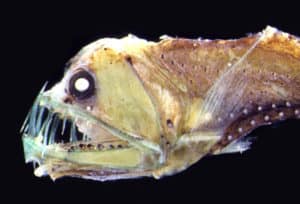 A viperfish is a kind of marine fish with the scientific name of Chauliodus sloani. It is found in tropical and temperate waters worldwide at the depths of up to 9,000 feet or 2,800 meters in deep sea. It is known as a ferocious hunter. The appearance makes it called monster. It has the size of 12-24 inches or 30 – 60 cm. The lifespan reaches 30-50 years. The big teeth indicates viperfish adapting to live in high pressure and low light condition. The diet include lanternfish, bristtlemouthes and other fish. The predators are sharks and dolphin. Human activities have little impact to the population.
A viperfish is a kind of marine fish with the scientific name of Chauliodus sloani. It is found in tropical and temperate waters worldwide at the depths of up to 9,000 feet or 2,800 meters in deep sea. It is known as a ferocious hunter. The appearance makes it called monster. It has the size of 12-24 inches or 30 – 60 cm. The lifespan reaches 30-50 years. The big teeth indicates viperfish adapting to live in high pressure and low light condition. The diet include lanternfish, bristtlemouthes and other fish. The predators are sharks and dolphin. Human activities have little impact to the population.
- Giant Isopod (Bathynomus giganteus)
 Giant Isopod is a kind of crustaceans with the scientific name of Bathynomus giganteus. It is the largest crustaceans and the largest member of the isopod family. Crustaceans has close relation to shrimp and crabs.
Giant Isopod is a kind of crustaceans with the scientific name of Bathynomus giganteus. It is the largest crustaceans and the largest member of the isopod family. Crustaceans has close relation to shrimp and crabs.
The scientists consider the giant body as a way of its adaptation to high pressure condition in deep sea. It includes Phylum Arthropoda and Family Cirolanidae. It has length of 7.5 – 14.2 inches or 19-36 cm. The habitat is in cold, deep waters of Atlantic, Pacific and Indian Ocean.
In reproduction, giant isopod lays eggs and it is strored until the young is ready to emerge. It lives in depth of 550 feet or 170 meters to 7,020 feet or 2,140 meters in bathypelagic zone. Mud or clay ocean bottom areas are favorite place to live solitary lives. Giant isopod is carnivores feeding live and dead animals, i.e. fish, crab, shrimp, squid, sponges and whale carcasses. The predators are sharks.
- Black Dragonfish (Idiacanthus atlanticus)
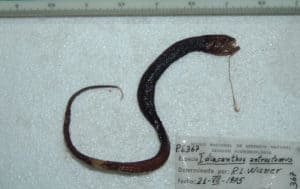 Black Dragonfish includes has Phylum Chordata and Family Stomiidae with the scientific name of Idiacanthus atlanticus. Female Black dragonfish has the length of 15 inches or 40 cm from its long tail to mouth. The male reaches 2 inches or 5 cm in long. The male is shorter than female in size. The difference between female and male Blackdragon fish relates “sexual dimorphism.” Male dragonfish has no teeth, no chin barbel and no digestive system. It has the main role of aiding the female in sexual reproduction.
Black Dragonfish includes has Phylum Chordata and Family Stomiidae with the scientific name of Idiacanthus atlanticus. Female Black dragonfish has the length of 15 inches or 40 cm from its long tail to mouth. The male reaches 2 inches or 5 cm in long. The male is shorter than female in size. The difference between female and male Blackdragon fish relates “sexual dimorphism.” Male dragonfish has no teeth, no chin barbel and no digestive system. It has the main role of aiding the female in sexual reproduction.
Then, it lives in mesopelagic to bathypelagic sea at depths of about 2,000 meters particularly temperate waters worldwide. The predator is Red Flounder fish. Black Dragonfish has only one defense, i.e. bioluminescence in its body. It is like light inside and outside of the body.
- Vampire Squid (Vampyroteuthis infernalis)
 Vampire squid is a kind of a small, deep sea cephalopoda with the scientific name of Vampyroteuthis infernalis. It includes Phylum Mollucsca and Family Vampyroteuthidae. It lives in temperate and tropical waters throughout the world in deep ocean. The habitat has the depth of 300 – 3,000 feet or 90 – 900 meters.
Vampire squid is a kind of a small, deep sea cephalopoda with the scientific name of Vampyroteuthis infernalis. It includes Phylum Mollucsca and Family Vampyroteuthidae. It lives in temperate and tropical waters throughout the world in deep ocean. The habitat has the depth of 300 – 3,000 feet or 90 – 900 meters.
In the condition, oxygen is minimum and no light. The temperature only reaches 2-6 degrees Celsius. Vampire squid is able to adapt in the condition. The size is 28 cm in length with mantle lengths of 7.9-12.1 cm.
In addition, the species is sexual dimorphism. Vampire squid feed copepods, prawns and cnidarians. The predators are deep-diving fishes, pinnipeds, whales, and benthopelagic fishes.
- Bathysaurus (Bathysaurus ferox)
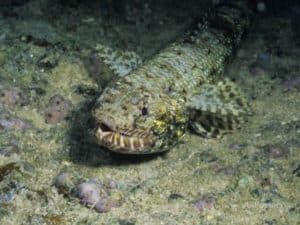 Deep-sea lizardfish is a kind of deepwater aulopiform fish with the scientific name of Bathysauridae ferox. It includes Phylum Chordata and Family Bathysauridae. There are two genus Bathysauridae, i.e. Bathysaurus mollis and Bathysaurus ferox. Bathysaurus ferox can reaches up to 26 inches or 65 cm in long.
Deep-sea lizardfish is a kind of deepwater aulopiform fish with the scientific name of Bathysauridae ferox. It includes Phylum Chordata and Family Bathysauridae. There are two genus Bathysauridae, i.e. Bathysaurus mollis and Bathysaurus ferox. Bathysaurus ferox can reaches up to 26 inches or 65 cm in long.
It lives between 3,280 – 8,200 feets or 1,000 – 2,500 meters in deep water. It prefers sea floor as the favorite area in temperate and tropical condition with the temperature of 4-3 degrees Celsius in Pacific, Atlantic and Indian Ocean.
Meanwhile, it eats fishes and decapods. Deep sea lizardfish is hermophrodites or external fertilization. The mating is not known yet. There is no predator because it is the apex predator.
- Frilled Shark (Chlamydoselachus anguineus)
 Frilled Shark is a kind of shark with the scientific name of Chlamydoselachus anguineus. It includes Phylum Chordata and Family Chlamydoselachidae. It lives in Atlantic, Pacific, Indian and Arctic Ocean at the depth of 165-4,200 meters or 50-1,280 meters in deep water. Mature male reaches 3.2-3.6 feet or 1-1.1 meters and female is 4.4-4.9 feet or 1.4-1.5 meters. The female is larger than male. Its maximum length reaches 6.4 feet or 2 meters. It has the reproduction mode of ovoviviparity. It can breed all years.
Frilled Shark is a kind of shark with the scientific name of Chlamydoselachus anguineus. It includes Phylum Chordata and Family Chlamydoselachidae. It lives in Atlantic, Pacific, Indian and Arctic Ocean at the depth of 165-4,200 meters or 50-1,280 meters in deep water. Mature male reaches 3.2-3.6 feet or 1-1.1 meters and female is 4.4-4.9 feet or 1.4-1.5 meters. The female is larger than male. Its maximum length reaches 6.4 feet or 2 meters. It has the reproduction mode of ovoviviparity. It can breed all years.
- Dumbo Octopus (Grimpoteuthis)
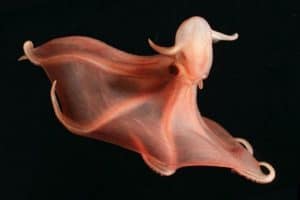 Dumbo octopus is a kind of Mollusca with the scientific name of Grimpoteuthis. It includes Phylum Molluscs and Family Umbrella octopus. It has 6 feet in length and 13 pounds in weight with 8 arms. Dumbo octopus has 37 different species found worldwide in all of the oceans. It lives between 9,800 -13,000 feet or 3000-4000 meters. Dumbo octopus is able to adapt to the intense pressure and cold temperatures in deep ocean. It eats crustaceans, bivalve, worms on the sea floor and copepods a kind of zooplankton. It does not have mating season.
Dumbo octopus is a kind of Mollusca with the scientific name of Grimpoteuthis. It includes Phylum Molluscs and Family Umbrella octopus. It has 6 feet in length and 13 pounds in weight with 8 arms. Dumbo octopus has 37 different species found worldwide in all of the oceans. It lives between 9,800 -13,000 feet or 3000-4000 meters. Dumbo octopus is able to adapt to the intense pressure and cold temperatures in deep ocean. It eats crustaceans, bivalve, worms on the sea floor and copepods a kind of zooplankton. It does not have mating season.
Female deposit eggs fertilized inside the body throughout the whole year. The lifespan reaches 3-5 years. Dumbo octopus is able to adapt to the intense pressure and cold temperatures in deep ocean. Killer whales and sharks are main predators of Dumbo octopus.
- Cookiecutter Shark (Isistius brasiliensis)
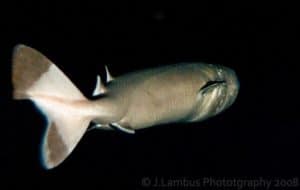 Cookiecutter Shark is a kind of small dogfish shark with the scientific name of Isistius brasiliensis. It includes Phylum Chordata and Family Dalatiidae. It is found in warm, temperate and tropical waters in Atlantic, Pacific and Indian Ocean particularly in deep water. It inhabits areas near the islands between 3,200-12,100 feet. Female body is larger than male. Male reaches 12-14,5 inches or 31-37 cm. Female is 15-17 inches or 38-44 cm. The reproduction system is ovoviviparity.
Cookiecutter Shark is a kind of small dogfish shark with the scientific name of Isistius brasiliensis. It includes Phylum Chordata and Family Dalatiidae. It is found in warm, temperate and tropical waters in Atlantic, Pacific and Indian Ocean particularly in deep water. It inhabits areas near the islands between 3,200-12,100 feet. Female body is larger than male. Male reaches 12-14,5 inches or 31-37 cm. Female is 15-17 inches or 38-44 cm. The reproduction system is ovoviviparity.
The diet large chunks of flesh removed from the body of large mammals and fish, squids, crustaceans, mesopelagic teleost fishes. It also parasitizes large pelagic teleosts, sharks, and cetaceans. It does vertical migration. It is seldom known to come to water surface. International Union for Conservation of Nature listed it as Least Concern.
So, the existence of these animals still assumed as an amazing existence. Thus, most of them are rarely can be seen by humans. As well as their unique shape and characteristics which many scientist also find them interesting. Howevr, we, as humans, must be protect their live to be spared from endangered status.